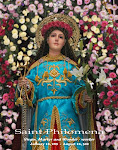At the New Liturgical Movement is a recent post about a parish that has "moved East", that is, has gone "ad orientem" in its celebration of the Ordinary Form...yes, even with the encouragement of the Bishop. How I wish my own bishop were as supportive and open minded to the idea of Ad Orientem worship. (sigh!)
Another Parish Moves East
The Ambrosian Gospel of the Fourth Sunday of Advent
-
This article is partly based on notes by our Ambrosian expert Nicola de’
Grandi.In many medieval uses of the Roman Rite, e.g. that of Sarum, the
Gospels of...
49 minutes ago










Our parish that exclusively celebrates the Ordinary Form of the Mass is both versus populum and ad orientam. The church is configured as such, that the priest is facing both the congregation and the east. I think newer parishes built in the diocese of Antipolo are configured that way. This is one example: http://marysblessing.blogspot.com/2011/10/diocesan-shrine-of-st-therese-of-child.html
ReplyDeleteGod bless you and your ministry, Father.
Your parish does ad orientem worship? where is that?
ReplyDeleteJust to clarify Father: it's ad orientam in a sense that when the priest celebrates mass, he is facing true east while also versus populum. Btw, it's the Sacred Heart of Jesus Parish, Cainta, Rizal. Forgive me if it sounded pilosopo.
ReplyDeleteWell, if it is truly ad orientem, then at the Liturgy of the Eucharist, the people should turn towards the east, even if it meant having their back toward the altar. Both priest and assembly must face towards the same direction. Versus populum is never part of the tradition of worship of the Church.
ReplyDeleteI will have to respectfully disagree with you on this, Father. And with all due respect, Father, if the people should turn towards the east, even if it meant having their backs to the altar, then who are they worshiping: the east or our Lord in the Eucharist at the altar? St. Peter's Basilica's Papal Altar (concecrated in 1594 by Pope Clement VIII) is also facing both east and the people, is it not? So I'm not so sure if such claims as versus populum "never being part of tradition" has any foundation. Furthermore, for centuries, Benedictine monks and the mendicant orders have celebrated and assisted Masses wherein they are around the altar. Their traditions are very much part of Church tradition of worship.
ReplyDeleteIn his book, The Spirit of the Liturgy, Joseph Cardinal Ratzinger quoted Cyrille Vogel: "Even when the orientation of the church enabled the celebrant to pray turned toward the people, when at the altar, we must not forget that it was not the priest alone who, then, turned East: it was the whole congregation together with him." (J. Ratzinger, The Spirit of the Liturgy, p. 79.)
ReplyDeleteIn the Book, Turning Towards the Lord: Orientation in Liturgical Prayer, Fr. U.M. Lang wrote: "The history of celebratio versus populum in the proper sense began in the late Middle Ages and the Renaissance, when the Christian principle of praying towards the east was little understood and began to fade away. De Blaauw records the significant stages in this development and shows how misconceptions about early Roman church architecture could arise when the principle of orientation was no longer understood. Nonetheless, the common direction of liturgical worship was retained, with very few exceptions (It is reported that Spanish missionaries from the mendicant orders as an experiment celebrated the Mass versus populum for the Aztec converts of central Mexico.)The idea that the priest should face the people during the celebration of Mass only gained currency in the Catholic Enlightenment of the 18th century. The rationalist Zeitgeist also affected liturgical practice and thought. Christian worship was supposed to be useful for the moral edification of the individual and for the building of society. Needless to say, this was at the expense of its latreutic and mystical nature; hence the espousal of the aesthetic ideal of 'noble simplicity'and the demands for the rites to be simplified and intelligible. These tendencies coincided with various currents in Catholicism that endorsed similar ideas, though partly for different motives, such as Jansenism and Josephism. However, it would seem that the call for Mass facing the people was hardly put into practice." (UM Lang, Turning Towards the Lord: Orientation in Liturgical Prayer, pp. 119-120.)
ReplyDelete